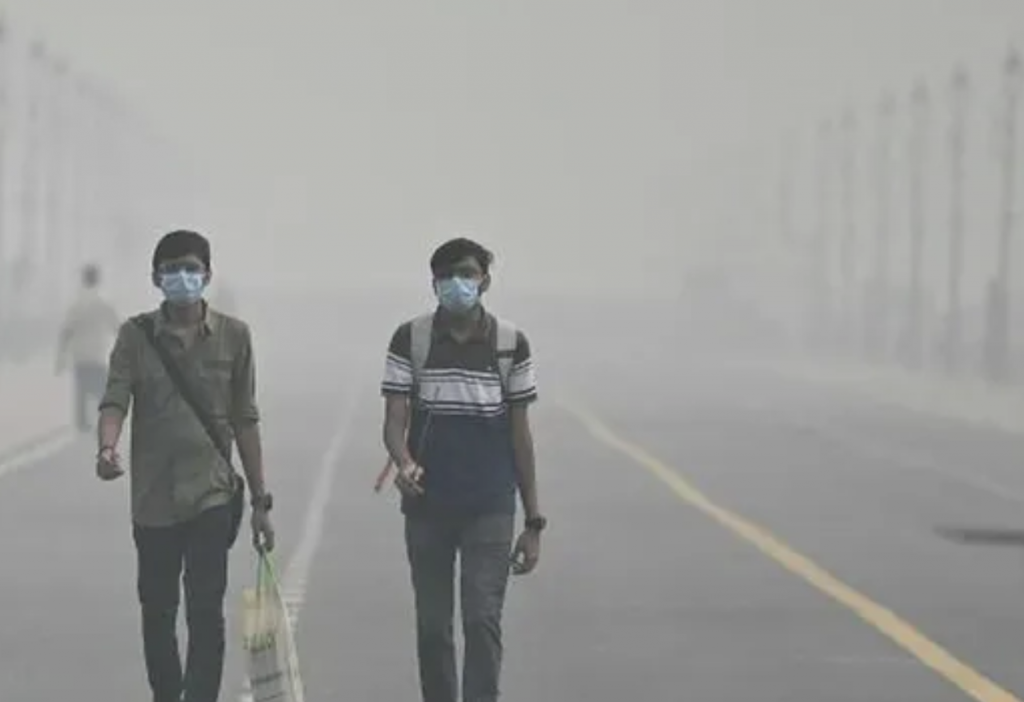New Delhi, Nov 8: On Wednesday morning, the air quality in Delhi and its surrounding areas fell into the bad category once more. One-third of the air pollution in the national capital is caused by smoke from burning post-harvest paddy straw in adjacent states. The city’s Air Quality Index (AQI) was 421 at 4 p.m. on Tuesday, down from 395 at that time.The amount of PM2.5, a type of small particulate matter that may enter the respiratory system deeply and cause health issues, was seven to eight times higher in the capital than the government-mandated safe level of 60 micrograms per cubic metre, even with a little decline. It was 30 to 40 times higher than the World Health Organization’s (WHO) recommended safe threshold of 15 micrograms per cubic metre. Hazardous air quality was observed in a number of cities along the Indo-Gangetic plains. Hazardous air quality was also observed in nearby Ghaziabad (382), Gurugram (370), Noida (348), Greater Noida (474), and Faridabad (396).The Decision Support System, a numerical model-based system that can identify sources of particulate matter pollution in Delhi, provided data on Tuesday that showed stubble burning in neighbouring states, particularly Punjab and Haryana, was responsible for 37% of the city’s air pollution. On Wednesday, it’s most likely to be 33 percent. following four years, the Delhi government said on Monday that it would bring back its popular odd-even plan in anticipation of significant declines in air quality following Diwali.Between November 13 and November 20, the odd-even program—which permits automobiles to run on different days depending on whether their number plates are odd or even—will be put into effect. Evidence for Policy Design and the Energy Policy Institute at the University of Chicago (EPIC) conducted an analysis of the odd-even system’s effects in 2016 and discovered that Delhi had a 14–16% decrease in PM2.5 levels during the system’s implementation in January of that year. When the programme was reinstated in April of that year, there was, however, no decrease in pollution.In addition, the administration decided to postpone in-person classes in all schools until November 10 in order to safeguard the health of pupils, with the exception of those in grades X and XII who are studying for board exams. The Delhi-NCR Air Quality Early Warning System of the Ministry of Earth Sciences predicts that the area would likely endure poor air quality for a further five to six days. According to doctors, inhaling Delhi’s contaminated air has the same negative effects as smoking around ten cigarettes a day. According to Rajesh Chawla, senior consultant in pulmonology and critical care at the Indraprastha Apollo Hospital, prolonged exposure to high levels of pollution can cause or exacerbate respiratory conditions like asthma, bronchitis, and chronic obstructive pulmonary disease (COPD), as well as significantly increase the risk of cardiovascular disease. In Delhi as well, tough regulations imposed by the Central government’s Graded Response Action Plan (GRAP), the last phase of its air pollution management plan for Delhi-NCR, have gone into effect.The implementation of stage IV of GRAP’s limitations, which include prohibiting all forms of development and the admission of trucks that cause pollution into the capital, began on Sunday following a decline in the capital’s air quality to severe plus (AQI levels exceeding 450). Four steps are used by GRAP to classify actions: AQI 201-300 for Stage I, 301-400 for Stage II, 401-450 for Stage III, and AQI above 450 for Stage IV, which is Severe Plus.Year-round, unfavourable weather patterns, car emissions, burning of paddy straw, firecrackers, and other local sources of pollution lead to dangerously high levels of air pollution in Delhi-NCR during the winter. Based on a research conducted by the Delhi Pollution Control Committee (DPCC), the city suffers its highest levels of pollution between November 1 and November 15, coinciding with an increase in the number of stubble-burning occurrences in Punjab and Haryana. Over the past two weeks, Delhi-NCR’s air quality has gotten worse because to a steady drop in temperature, calm breezes that trap pollution, and an increase in the burning of post-harvest paddy straw throughout Punjab and Haryana. Of all the capital cities in the world, Delhi has some of the worst air quality. According to an August EPIC research, Delhi’s air pollution is reducing life expectancy by over 12 years.


